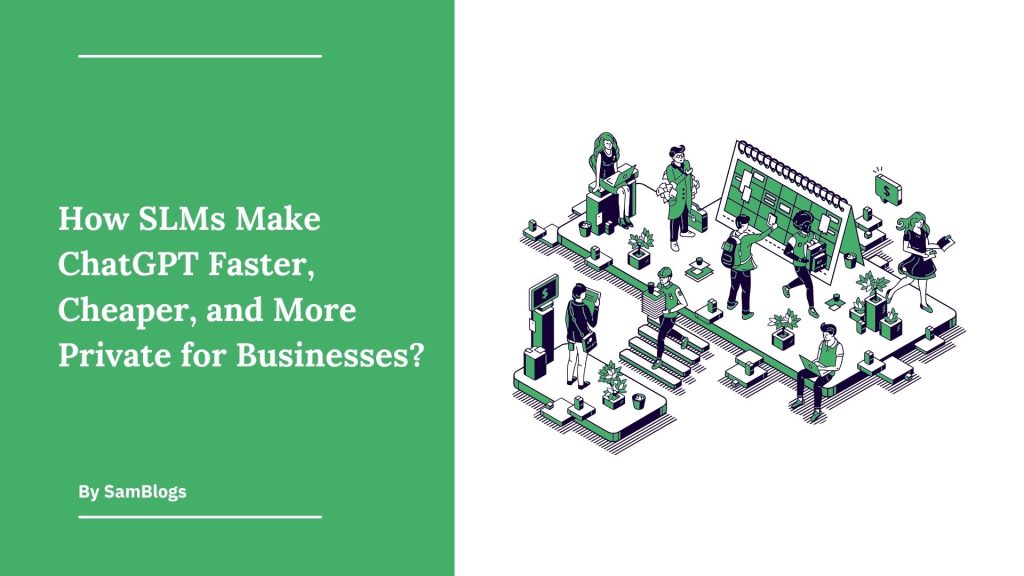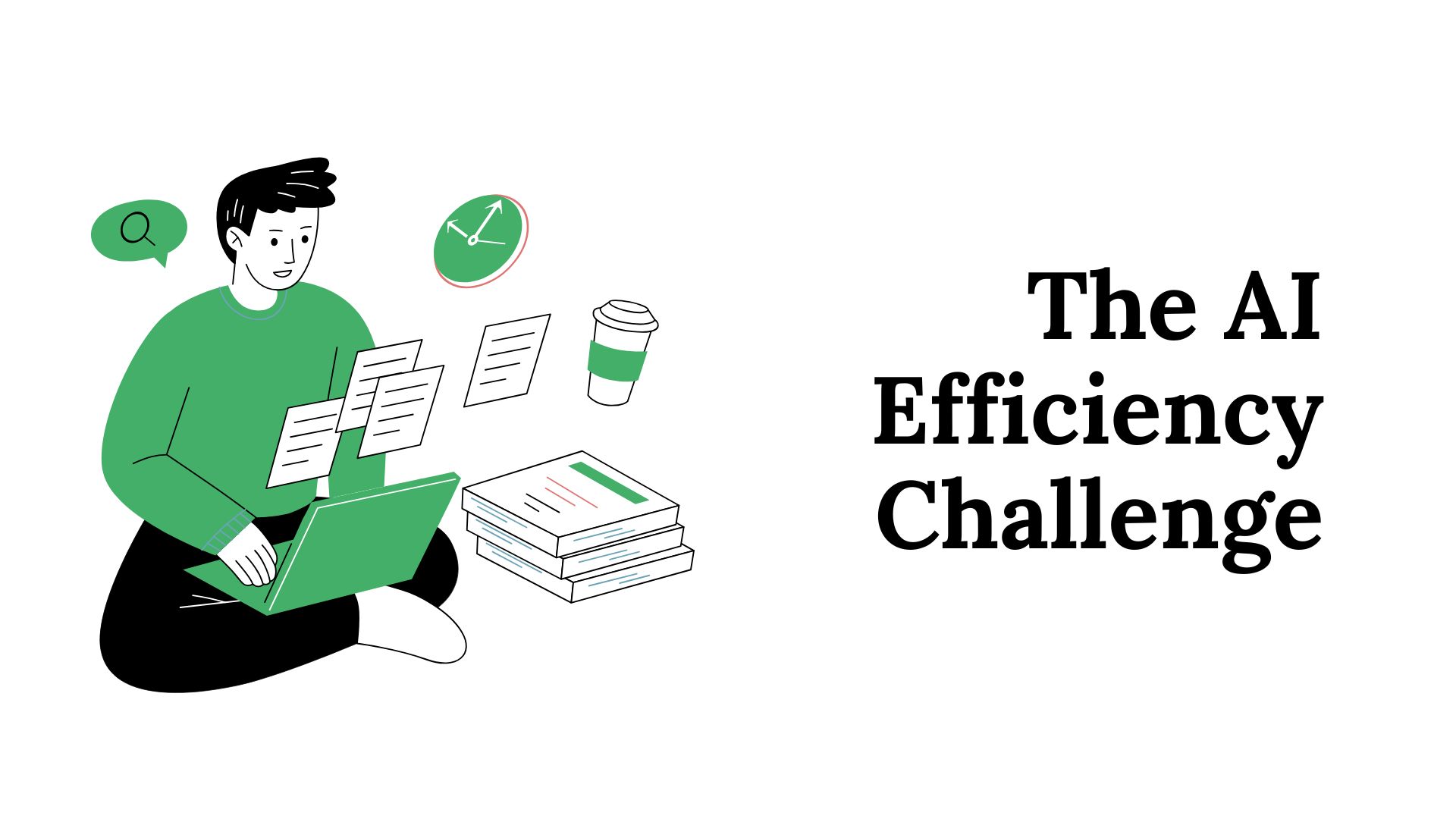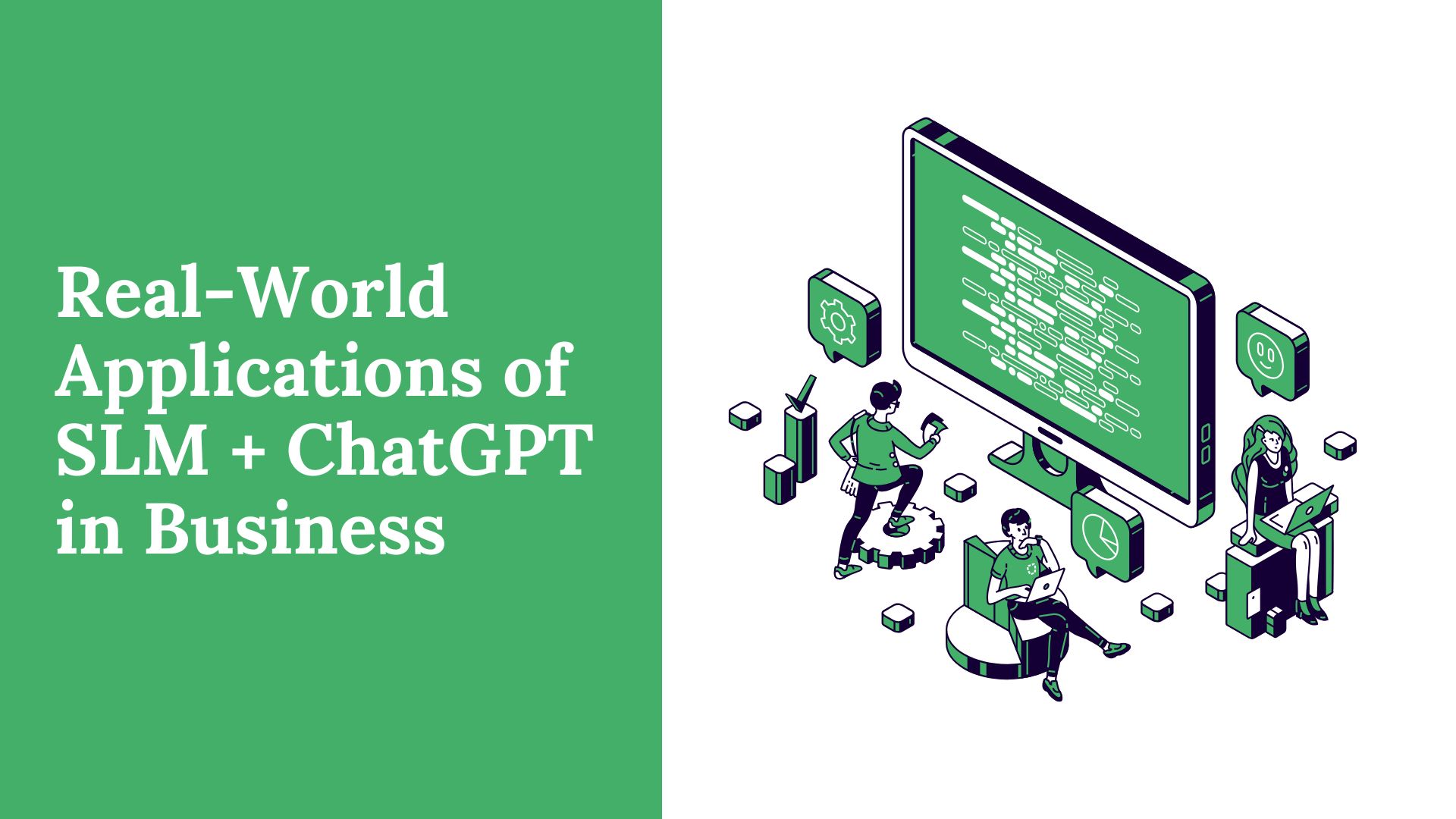As several businesses and organisations are integrating AI with their working facilities, the center of focus mainly relies on a few factors. For instance, you can refer to the company’s efficiency, information privacy, and cost. Although various LLMs (Large Language Models) like GPT or Perplexity can provide robust automation features, there are also several backdrops we can notice.
For example, despite the smoothness and efficiency of the Large Language Models, they can often be resource-demanding and excessive for repetitive and basic operations. Moreover, for handling these scenarios, companies mainly implement the SLMs (Small Language Models) into their workflows for achieving similar tasks.
In this article, we will talk about how Small Language Models (SLMs) can make Large Language Models (LLMs) such as ChatGPT cheaper, faster, and more private for your business.
Contents
- 1 The AI Efficiency Challenge
- 2 Comprehending Small Language Models (SMLs) And ChatGPT
- 3 Why Small Language Models Make ChatGPT Faster?
- 4 Cost Efficiency: Making AI Affordable for Business
- 5 Privacy And Data Security Advantages
- 6 Hybrid AI Strategies for Business
- 7 Real-World Applications of SLM + ChatGPT in Business
- 8 Challenges And Considerations
- 9 Future Outlook: SLMs As A Business Game-Changer
- 10 In Conclusion
The AI Efficiency Challenge
Although the Small Language Models (SLMs) can offer you several benefits, various risks and trade-offs might require you to calculate your steps carefully.
For instance, you can refer to:
- Knowledge Anandeneralization Scope: As the Small Language Models (SLMs) are smaller and more compact, they may perform inefficiently when a specific operation goes out of their training programs.
- Reasoning and Complex Tasks: There are various tasks that Small Language Models (SLMs) may perform, like those that full-scale Large Language Models (LLMs). For instance, they have wider world knowledge, several steps of reasoning, and bigger context windows.
- Maintenance, Data, and Fine-tuning: To get efficient personalization and accuracy, you still require various operational facilities. For example, you can refer to quality training and fine-tuning data, model drift mitigation, and observation.
- Integration Complications: If you deploy smaller specialized models, it may produce various architectural complexities. For instance, they are mainly routing logic, several models, and versioning.
Comprehending Small Language Models (SMLs) And ChatGPT
You can mainly refer to Large Language Models as AI facilities that generally consist of billions of parameters. Moreover, they are also general-purpose facilities that are operational on several tasks.
For example, they are primarily functional on massive and diverse datasets and capable of managing a broad range of language operations. Nonetheless, there are also various key characteristics of LLMs (Large Language Models) that you can follow:
- Scale: Large Language Models have extremely large parameters, which require resource-efficient computing.
- General Intelligence: LLMs are operational on extensive internet-scale data and can regulate almost any kind of task.
- High Precision: These language models are efficient at various tasks. For instance, they are mainly creative writing, reasoning, and open-ended discussions.
- Implementation Cases: There are several implementation cases of LLMs, such as Chatbots, research summarization, coding assistants, and creative writing.
Conversely, you can generally refer to Small Language Models (SLMs) as AI facilities with fewer parameters that generally contain under 30 billion parameters. Moreover, they are mainly functional for various factors such as speed, domain specialization, and efficiency.
Capabilities of SLM Models
Furthermore, the SLM models mainly contain similar capabilities to Large Language Models (LLMs). However, you can also optimize them for certain industrial and business operations. Nonetheless, here are some major characteristics you can follow:
- Domain-Oriented: You can train or fine-tune the Small Language Models (SLMs) on your industry-driven and business tasks.
- Efficiency: The SLMs require less computational efficiency than the Large Language Models, which generally consist of lower costs and faster responses.
- Privacy-Friendly: Small Language Models are convenient for deploying on premises or at the edge of your network while keeping the sensitive information local.
- Personalization: These language models are cheaper and convenient to adjust to a certain user case.
- User Cases: The SLMs have various user cases. For instance, they are mainly document summarizations, compliance checks, customer service chatbots, HR Q&A, and many more.
Why Small Language Models Make ChatGPT Faster?
As the progress of Artificial Intelligence has taken a rapid leap, the matter of efficiency has become as crucial as intelligence itself. Although the Large Language Models (LLMs) like ChatGPT-4 and 5 are mainly famous for creativity, contextual comprehension, and sophistication, they generally require high computational resources.
On the other hand, the Small Language Models (SLMs) require fewer computational resources and are cheaper than the LLMs. Alongside, while being resource-friendly, they can also process similar works just like the LLMs. Nonetheless, here are some reasons why the Small Language Models can make ChatGPT faster:
Decreased Computational Load
One of the most direct reasons Small Language Models (SMLs) can make ChatGPT faster is their compact size. The Large Language Models (LLMs) generally consist of billions of parameters, while Small Language Models (SLMs) can process the same tasks while having only a few million or billion parameters.
Moreover, as SLMs have fewer parameters to compute and process during every query, they can complete calculations and tasks more swiftly. Also, the following reduction in computational process generally indicates that you can generate responses in a lesser time while also decreasing latency for various users.
Task Specialization And Optimized Model Routing
Several facilities, like ChatGPT, sometimes implement model routing where small facilities generally regulate the straightforward requests. For instance, you can mainly refer to short summaries, grammar correction, and factual lookups, while the LLMs mainly handle the tasks that are more creative, complex, and require nuanced reasoning.
Moreover, the following format ensures that the Small Language Models (SLMs) allocate computational efficiency more prominently. For instance, if a user asks for a general math question, ChatGPT can assign the question to a proficient Small Language Model rather than looking for an extensive Large Language Model.
Bandwidth Requirement And Lower Memory
Among all reasons behind the speed efficiency of Small Language Models (SLMs), their memory efficiency is undoubtedly a crucial factor. This is mainly because the SLMs have fewer parameters, which requires less memory to load and less bandwidth to process data between processors.
Moreover, the following procedure also allows the Small Language Models (SLMs) to operate efficiently despite being on edge devices and low-latency servers. Furthermore, in distributed facilities, where different models respond across networks, smaller models can decrease data transfer while making communication arrive swiftly and more consistently.
Scalability And Energy Efficiency
Speed in Small Language Models (SLMs) is not merely functional to computation, as it also relies on energy efficiency. Also, LLMs or Large Language Models process immense data for maintaining their performance. Conversely, Small Language Models, opposingly, can deliver more efficient results while also consuming less energy.
The following process not only decreases the environmental influence but also allows the cloud distributors to calculate their systems more efficiently.
Cost Efficiency: Making AI Affordable for Business
AI has become the foundation of modern innovation while driving various factors. For instance, you can refer to advances in productivity, decision-making, and customer participation across most industries.
Nonetheless, despite its probable potential, one of the primary obstacles to developing AI still falls on its development cost. Moreover, for making AI truly accessible across several industrial fields, different organisations mainly have to prioritise the matter of cost efficiency. Furthermore, here are some points that you can follow:
Higher Charges for Extensive AI Models
Conventional AI development, especially with LLMs (Large Language Models, comes with extensive operational charges. Moreover, if you train a particularly large AI model, it may require a million-dollar investment in cloud computing resources and months of processing in specialized software like TPUs and GPUs.
However, other than model training, the ongoing interference that runs the model for generating predictions or responses also extracts computational energy and substantial energy.
The Emergence of SLMs (Small Language Models)
Among all the most effective tactics for optimizing the cost efficiency for AI models, Small Language Models (SLMs) are one of the most significant options you can rely on. These smaller AI models generally operate by performing certain tasks and calculating the large model capabilities with fewer parameters and lower computational necessities.
The Small Language Models (SLMs) can decrease both interference and training cost by extracting various factors. For instance, you can refer to energy, processing power, and less memory.
On-Demand Scalability And Cloud Optimization
Cloud computing generally has one of the most crucial roles for democratizing artificial intelligence. Moreover, it mainly does it by letting several companies and businesses charge for only what they implement for their work.
Also, the cost-efficient AI tactics generally leverage on-demand scalability, where you can adjust your resources dynamically while relying on the workload. Furthermore, instead of regulating demanding servers that are functional all the time, companies can also implement serverless architectures that measure the AI workloads concurrently.
Privacy And Data Security Advantages
Privacy and data security have become a prominent aspect in our daily lives as well as in industrial workflow with the rise of AI. Despite the efficiency of LLMs (Large Language Models), they sometimes require several factors that raise prominent concerns regarding compliance and data exposure.
For instance, you can refer to the continuous cloud connectivity, centralized processing, and extensive datasets. Conversely, the SLMs (Small Language Models) provide a more secure and privacy-conscious approach for deploying AI. Nonetheless, here are the advantages of data security and privacy of SLMs you can refer to:
On-Device Processing: Keeping Data Local
The Small Language Models (SLMs) have the privacy advantage of running locally on several devices. For instance, you can refer to edge servers, smartphones, and laptops. Moreover, it is mainly because they require less computational efficiency and memory than the Large Language Models (Large Language Models).
On the other hand, Small Language Models can function without requiring sending the data information to the cloud storage for processing. As a result, it eliminates several privacy risks that you can associate with remote storage and data transmission. For example, you can refer to unauthorised access, accidental leaks, and interception.
Decreased Data Exposure And Surface Attack
As Small Language Models (SLMs) function on smaller Infrastructure and do not rely heavily on centralized cloud facilities. Moreover, they can also normally decrease the surface attack, which is vulnerable to probable cyber risks. Also, if there are fewer data connections, it generally indicates fewer vulnerabilities that hackers can exploit.
Furthermore, the extensive centralized AI facilities sometimes aggregate information from millions of users to clean their models. In turn, it also increases several risks of data misuse and breaches. On the other hand, you can fine-tune or deploy Small Language models on isolated infrastructures while also decreasing the exposure of sensitive data or proprietary data.
Greater Regulation and Personalization
Small Language Models (SLMs) let companies and organisations maintain greater control over their AI behaviour and data pipelines. Instead of depending on third-party distributors for managing their storage and models, different companies can deploy Small Language Models within their own secure environment.
Moreover, the following procedure also ensures complete transparency over the location of the data storage, its processing function, and the person carrying the access.
Hybrid AI Strategies for Business
When we are talking about SLMs or Small Language Models, there are several advantages that we can gain from integrating with Hybrid AI. For instance, you can refer to allowing various companies to balance their scalability, maintenance, and efficiency while also leveraging their AI facilities. Nonetheless, here are some points you can follow:
Resource Optimization
One of the most prominent advantages of integrating hybrid AI into Small Language Models is resource optimization. In this case, you mainly have to deploy the Small Language Models locally for several predictable and frequent tasks.
For instance, you can refer to internal chatbot assistance, document summarization, and email drafting. Moreover, by deploying the SLMs for these tasks, organizations can decrease their reliance on high-cost cloud APIs. Also, when you require extensive context comprehension alongside complex reasoning, the system can move the problem to the externally hosted larger model.
Enhanced Data Governance And Security
Among all the benefits you can gain from integrating hybrid AI into SLMs is security and enhanced data governance. As you can mainly deploy Small Language Models (SLMs) on premises, sensitive customer and corporate data can stay within a properly maintained infrastructure.
Moreover, this approach is primarily crucial for various organisations, such as law, commerce, and healthcare, where confidentiality and compliance are important factors. Furthermore, the hybrid strategy also makes sure that you process the data-intensive tasks internally while only aggregated and anonymized data contacts with the external facilities.
Constant Learning And Adjustability
There are a lot of hybrid strategies that you can implement in your workflow, and one of them is constant learning and adjustability. Also, you can periodically retain the Small Language Models with local business information while mirroring the progressing market movements or company regulations.
Conversely, large organisational foundation models may keep their positions static or need broad retaining. Moreover, the following adjustability enables companies and businesses to regulate a pertinent and agile AI infrastructure.
Real-World Applications of SLM + ChatGPT in Business
As AI facilities are continuously redefining business strategies, several companies are adjusting hybrid AI infrastructures that integrate SLMs with large AI models like ChatGPT.
Nonetheless, here are some real-world applications of SLM and ChatGPT in business:
Customer Assistance And Experience Management
One of the most constant and influential applications of Small Language Models and ChatGPT integration mainly stays in customer service automation. As companies locally deploy Small Language Models to manage low-complexity, frequent inquiries, reducing operational costs and response times.
Brand Communication And Marketing Content
In communication and marketing, the SLM and ChatGPT models allow groups to leverage their content development while regulating their brand consistency. Moreover, a personalized Small Language Model can fine-tune an organization’s style, product information, and tone.
Challenges And Considerations
Following our previous mention, there are various reasons why most of the companies and organisations choose SLMs (Small Language Models) over LLMs (Large Language Models) for their work.
Shortly, it is generally because they are resource-friendly, cheaper, and more private. However, here are some useful points that you can follow:
Speed, Efficiency, And Responsiveness
As Small Language Models (SLMs) have fewer parameters, this system requires less proficiency during the interference phase, alongside lower latency and less memory. Moreover, the procedure is a useful process because lower latency is an efficient source for various concurrent applications.
For instance, the following applications are mainly customer service, internal conversational assistants, and chatbots.
Cost And Infrastructure
SLMs generally require you to process fewer GPU and TPU resources to operate and deploy them. For instance, it decreases the charges for both interference and training and fine-tuning. Moreover, you can also sometimes deploy less efficient hardware facilities to operate your workflows.
Data Control, Privacy, And Domain Specialization
If you implement a Small Language Model in your domain, it can provide you with more control over model behaviour and training data. Moreover, it mainly indicates you have a better ability to comply with various factors.
For instance, they are mainly internal governance and industry regulations, alongside neglecting black-box risks. Nonetheless, these domain-specific models can also outperform several competitors on narrow activities for better precision in your business domain.
Future Outlook: SLMs As A Business Game-Changer
As we look towards the future outlook of Small Language Models in business, it can redefine the organizational infrastructure through complex workflow automation and enhanced multi-functional collaboration. For example, instead of carrying distinctive models for supply chain organization, customer analytics, etc, SLMs can synchronise all the following procedures.
In Conclusion
SLMs or Small Language Models generally indicate a crucial progress in how AI can maintain organizations that offer intelligence and efficiency of large AI models like ChatGPT. Also, if you run the AI models on a private or local environment, Small Language Models can deliver swift responses, enhance data privacy, and minimize latency while keeping sensitive data in-house.






